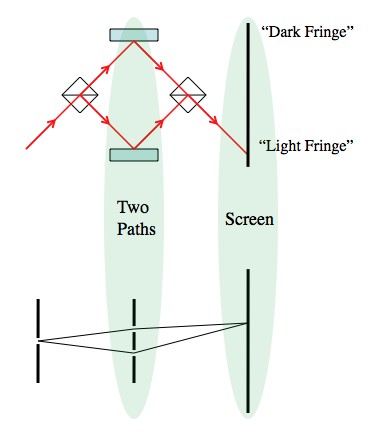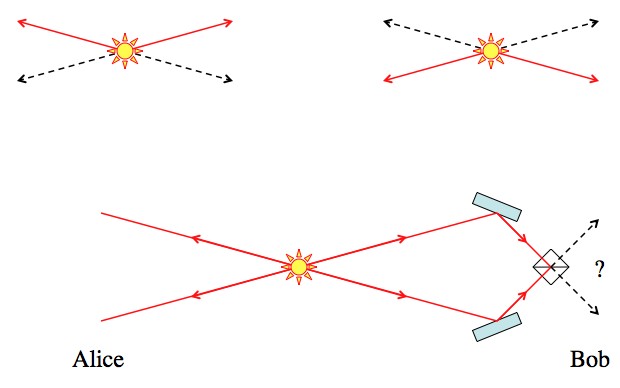Physicist: There are a lot of big claims made about entanglement, but there are two carved-in-stone facts that help cut through some of the more grandiose claims. First, (maximally) entangled states always act exactly like a perfectly random state, until you compare the two. There’s nothing special about one half of an entangled pair of particles, but there’s a lot special about two of them together. And second, under no circumstances does anything you do to one particle have any effect on the other. Never. Never ever, in fact.
Delayed choice experiments are among many attempts (generally successful) to gain a better understanding into the nature of measurements in quantum mechanics, and to ferret out the role of the “observer”. The results so far are that “observers” and their observations only matter to the observers themselves*, wave function collapse is a mathematical artifact*, and (sadly) there’s still no way to send information faster than light.
There are a lot of experiments that can be called “delayed choice” experiments (here’s a good one!), but the idea behind delayed choice experiments is fairly straight forward. The results of the double slit experiment are sometimes described as “if you know what slit a photon goes through, then there is no interference pattern, but if you don’t know which slit it went through, there will be an interference pattern” (details). The fact that the double slit experiment involves slits is unimportant. What matters is that there are two paths for photons to take, and that those paths can interfere.

The original double slit experiment (bottom) which produces many light and dark fringes and a more modern set up (top) which produces one dark path and one light path in lieu of fringes. The squares are beam splitters. By carefully arranging everything you can get photons to always come out of one side of the last beam splitter
First, introduce a source that produces pairs of entangled photons. Entangled particles have the property that if the same measurement is made on both particles, then the results will always be the same (there are different kinds of entanglement, but this is the simplest to keep track of). Generally this only applies to one property of the particles (spin, direction of movement, etc.). In this case the entangled property is the direction, or the “which path information”.

The source of entangled photons sends them in a combination of “both up” or “both down” (top). Far away from each other, Alice and Bob each receive one of those photons, and can interfere them in very much the same way the double slit experiment does (bottom).
So here’s the idea; two people, Alice and Bob, are each sent one of the two entangled particles (each of which arrives on two paths, like the double slit). If Alice looks at her particle and finds out which path it’s on, then suddenly Bob’s photon will similarly only be on one path*. But that means no interference, and Bob should be able to tell whether or not there’s interference. In particular, he’ll start seeing photons in what should be the dark path. “Holy crap”, he thinks, “Alice must have looked at her photon”. There are a lot of different versions of “delayed choice” type experiments, but this is the basic idea.
But there’s a huge problem here; at no point did Alice and Bob communicate, and it doesn’t matter how far apart they are, so this is a method for faster-than-light communication. Supposedly, Alice can send a signal to Bob just by either looking at, or not looking at, her own photon. However! It turns out that exactly like every other “cheat” involving entanglement, it’s impossible to even tell that your particle is entangled with another one until you compare the two.
The following math is pretty easy, it’s just that the notation is scary. There will be no quiz, so don’t stress.
The state of a photon taking the bottom path is “” and if it’s taking the top path it’s in the state “
“. Beam splitters take
to
, and take
to
.
So for example, two beam splitters applied one after the other to a “bottom state” is: . This is exactly the situation in the top most picture!
By the way, the number in front of a state is its “probability amplitude”, and the square of that is the probability of seeing that state. So that means that each of the states has a 1/2 chance of being seen if the photon were detected (it has a 50/50 chance of being seen on either path).
That “” thing is a superposition of the top and bottom paths, which interferes at the second beam splitter. So, hopefully, each of the entangled photons will be in that same state and will interfere similarly, with similar results. Unfortunately, that’s not the case even a little.
The entangled photons are created in the state ; a combination of “both up” and “both down”. The subscripts, A or B, indicate which photon goes to which person, Alice or Bob.
What does Bob see if Alice does nothing? The state starts as: . When Bob gets his photon he interferes it in the beam splitter:
So here’s what that mess means: there’s a 50/50 chance of the photons being in either of the states or
. As far as Bob is concerned, that means that there’s a 50/50 chance of detecting it on either path. No interference.
What does Bob see if Alice looks? Everything works the same right up until the last step, so the state is: . All 4 of these states are equally likely (since,
). If Alice looks and sees the photon on either path, then two of those four states will collapse*. If she sees the photon in the top path, then the state of the system becomes
and if she see’s it on the bottom path, then the state of the system becomes
. In both cases, Bob has a 50/50 chance of seeing it on either path. No interference!
That said, the states and
are fundamentally different, it’s just that Bob won’t know which he has until Alice tells him the result of her measurement (by calling or writing or something). This is actually the basis behind quantum teleportation!
This particular experiment doesn’t in itself prove anything, but every similar experiment has the same result: no communication. What if Alice and Bob look at different times? What if whether or not Alice looks is itself decided by some other quantum thing? What if you use lots of entangled pairs, or other kinds of quantum states, or do the experiment hanging upside-down while yodeling the Beatles? Really, think of a permutation, and some lab somewhere has tried it. All of them have verified the Quantum No-Communication Theorem.
*Answer Gravy: The things above with an asterisk are better explained using Relational Quantum Mechanics. The idea behind RQM is that measurements don’t do anything “special”, and quantum laws always apply (nothing fundamentally changes between the atomic and macroscopic worlds). I’m a big fan, but please take my opinions (not the math, but the interpretation of the math) with a big grain of salt. It’s an “interpretation” after all, not a “law”.
Before Alice looks at her photon she’ll be in the state . If she looks and sees the photon in the top path, then suddenly she’ll be in the state
. That isn’t particularly profound. When things interact they’re each affected, and in this case the effect on Alice is remembering that the photon took the top path (also maybe a commemorative lab party with top hats). The “just go ahead and Look at the particle” operation, L, does this:
. The same idea for
, and of course Bob can look as well.
Now, assume that Alice and Bob are somehow extremely isolated from each other. No information of any kind can pass between them (no sound, light, particles of any kind, etc.). This sort of isolation is almost certain to be completely infeasible for people (it’s hard enough to keep just a handful of particles Isolated). That means that in practice, here on Earth in actual labs, when one person makes a measurement, both do. So, are you in a superposition of both reading and not reading this post, from the point of view of someone on the opposite side of the Earth? Very unlikely. But never mind all that: presume Alice and Bob are Isolated.
Now say each of them have one of the entangled particles (no beam splitters or anything this time) and they haven’t looked at them. The state they start out in is . Alice and Bob are both in one state, from each of their points of view. Now say Alice looks (that means “apply
“).
If you’re asking “does this mean that Alice is in two states at the same time, like a particle?”, the answer is yes. And why not? Other than being the weirdest thing ever, what’s really wrong with it? So, from Bob’s perspective, Alice is now in a superposition of states.
But now there’s a problem. Does it now make sense to consider Alice’s perspective? In order to ask “what does Alice see?”, you have to consider which “version”. The “t” version sees the world like this: . Bob hasn’t look at his particle yet, but when he does he’ll see it in the top state. From this Alice’s perspective, the state of Bob’s particle has undergone “wave function collapse” into the top state. In exactly the same way, the version of Alice that saw her particle in the bottom state will find that Bob’s particle “collapsed” to the bottom state. They both saw a fundamentally random result, yet immediately learn from it the state of a distant particle.
In case you’re wondering, if Bob then looks, the overall state becomes . For both versions of both Alice and Bob, the whole process was random, and the only thing they’ll notice, if they ever compare notes, is that they measured the same thing.
Deeply weird, but deeply unfantastic.







6 Responses to Q: What are “delayed choice experiments”? Can “wave function collapse” be used to send information?